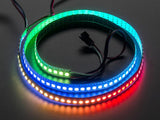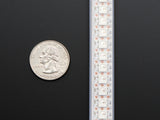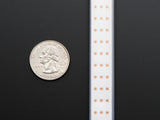We crammed ALL THE NEOPIXELS into this strip! An unbelievable 144 individually-controllable LED pixels on a flexible PCB. It's completely out of control and ready for you to blink. This strip has a white mask, and an extra heavy flex PCB.
These LED strips are even more fun and glowy. There are 144 RGB LEDs per meter, and you can control each LED individually! Yes, that's right, this is the digitally-addressable type of LED strip. You can set the color of each LED's red, green and blue component with 8-bit PWM precision (so 24-bit color per pixel). The LEDs are controlled by shift-registers that are chained up and down the strip so you can shorten or lengthen the strip. Only 1 digital out pin is required to send data. The PWM is built into each LED-chip so once you set the color you can stop talking to the strip and it will continue to PWM all the LEDs for you.
All your high-density LED dreams answered, yet there are a few things to watch for.
- First up, the ultra-high density means much higher power usage over a certain distance -35 Watts max (~7 Amps @ 5V). The max rating is assuming all the LEDs are on full white, usually the actual current for colorful design is about 1/3 to 1/2 the max current. A good power supply such as our 5V 10A supply is key!
- Second, to get high density, the controller chip is inside the LED, which is kind of cool, but also means that the chip only uses a single pin for input and a single pin for output. The protocol used is very very timing-specific and can only be controlled by microcontrollers with highly repeatable 100nS timing precision. We have example code for using with the Arduino Uno/Mega microcontroller at 8MHz and 16MHz, and with a little effort you can use with the Raspberry Pi, or Beagle Bone Black, but it will not work with the Basic Stamp, NETduino, any other interpreted/virtual machine microprocessor or any processor slower than 8 MHz.
- Third, just because you have all those pixels doesn't mean you have the RAM for it - the entire strip must be buffered in memory, and we've found many Arduino UNO projects only have about 1500 bytes of RAM available after all the extras are included - enough for about 2-3 meters of the 144 LED pixels. If you want to drive multiple meters and have some other libraries included, use a Mega.
- This strip now comes with a weatherproof sheathing, you can remove it if not wanted, with a pair of scissors
The strip is made of flexible PCB material, you can cut this stuff pretty easily with wire cutters, there are cut-lines every LED. Solder to the 0.1" copper pads and you're good to go. Of course, you can also connect strips together to make them longer, just watch how much current you need! You must use a 5V DC power supply to power these strips, do not use higher than 6V or you can destroy the entire strip.
They come in 1 meter strips with a 2 or 3-pin JST SM connector on each end and separated power/ground wires. These strips are sold by the meter! There is a join in the middle of the strip and the LEDs are not perfectly spaced at that point - it's just a tradeoff with the ability of the flex PCB maker and density.
To wire up these strips we suggest picking up a 2.1mm DC jack to wire in so you can connect one of our wall adapters to power it. You can connect to the input side with any sort of wire.You'll probably want a 3-pin JST set to turn it into a quick connection.
Technical Details
Technical specs:
- 144 LEDs per meter
- Maximum 5V @ 60mA draw per LED (all LEDs on full brightness)
- 5VDC power requirement (do not exceed 6VDC) - no polarity protection!
- 1 integrated RGB LEDs per segment, individually controllable
- LED wavelengths: 630nm/530nm/475nm
- Connector: 3-pin JST SM
- Dimensions: 1000mm / 39.37" x 12mm / 0.47"
- Power Lead: 196.85mm / 7.75"
- Connect Lead: 92.07mm / 3.62"
- Weight: 35.42g
- We currently ship this product with the WS2812B 4-pin chip LED installed. Previous versions may have come with the WS2812S 6-pin LED. Both B and S LEDs can be chained together and are compatible with the NeoPixel Libary. The 'B chip type adds additional polarity protection and is the same brightness as the 'S type.











